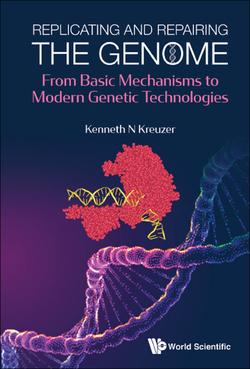Читать книгу Replicating And Repairing The Genome: From Basic Mechanisms To Modern Genetic Technologies - Kenneth N Kreuzer - Страница 10
На сайте Литреса книга снята с продажи.
Chapter 1 The challenges of maintaining and duplicating the genome 1.1Introduction
ОглавлениеThe human genome consists of about 3.3 billion base pairs of DNA spread between the 23 chromosomes. With the exception of the sex chromosomes in males, all the chromosomes are present in two copies, one from each parent, and thus the total sequence length in a human cell is about 6.6 billion base pairs. This DNA sequence complexity determines the precise amino acid sequences of many thousands of proteins, the nucleotide sequence of numerous structural RNAs, and myriad regulatory signals that dictate when genes are turned off and on in response to organism development, nutritional conditions, and stress or disease states. The size of the genome in base pairs can be appreciated by comparing it to the average length of one of the Harry Potter books, roughly 0.7-million alphabet letters. It would take something like 5000 Harry Potter-length books to print out one copy of the information stored in the human genome!
Another way to appreciate the length and complexity of our DNA is to think about all human DNA in your body at any one time. Estimates of the total number of human cell nuclei in an average adult are in the range of 7 trillion.1 The 6.6 billion base pairs of DNA in the human cell nucleus has a length of about 2 m, and so the human DNA in your body would be about 14 trillion (1.4 × 1013) m long if it were lined up end to end. Well, 14 trillion m equals 14 billion (1.4 × 1010) km, and consider that the distance from the earth to the sun is about 0.15 billion (1.5 × 107) km. Your DNA could therefore stretch to the sun and back about 45 times!
In spite of its 6.6-billion base-pair length, the sequence of the genome is passed down to daughter cells with remarkable accuracy in every cell division during a human lifetime. Current estimates of the error rate for this process are in the range of one per billion (109) to one per ten billion base pairs replicated — it sounds even more impressive when this is expressed as an accuracy rate — 99.9999999% of the base pairs are copied correctly (at one error per billion). Comparing again to the Harry Potter books mentioned above, this would be like copying the 5000 imaginary Harry Potter books while making no more than a few mistakes — the vast majority of the 5000 books would be perfect. We will see that the impressive accuracy of genome replication results from a combination of a very accurate DNA replication machine combined with powerful DNA repair pathways, most of which restore the original nucleotide sequence and thereby avoid errors. Furthermore, as we will see, the DNA replication and repair machineries provide a remarkable resistance to DNA damage from both endogenous toxins like oxygen radicals and exogenous sources like the UV in sunlight and the many environmental chemicals that can damage DNA.
The extreme accuracy of the replication process is even more impressive when one considers the speed at which the cellular DNA can be replicated prior to cell division. Rapidly growing human cells can double about once every 24 hours. Ignoring the fact that only part of this time is used for DNA replication, this still translates to a rate of replication (for the entire genome) of nearly 50,000 nucleotides per second! Some other eukaryotes display even faster replication rates. For example, very early Drosophila fruit fly embryos replicate their genome in about 8 minutes, for an overall rate of over 600,000 nucleotides per second. These very high rates of replication can only be achieved by using multiple replication machines simultaneously, similar to having 5000 people each copying one of the imaginary Harry Potter books to complete the job in a shorter period of time. If you consider a single replication machine in the human system, the rate of replication is on the order of 30 base pairs per second, while bacterial replication machineries can achieve a rate of about 1000 base pairs per second. If human cell replication utilized only a single replication machine, it would take roughly 7 years to replicate all the DNA in one cell at the rate of 30 base pairs per second.
